The 2007 collecting trips were beyond all our expectations.
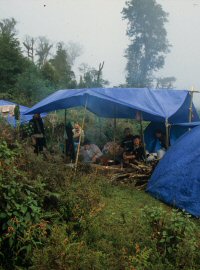 |
Camp at Y Ty
Peter Wharton joined me in the north of Vietnam, where I had been collecting with the aid of a motorbike. I had secured permits for collecting in a restricted area, where Peter would conduct a survey of this previously un-botanised area, while our Vietnamese host, Du was collecting specimen for his institute. The weather was dreadful, I wasn’t sure if I was going to end up with webbed feet or trenchfoot. Whatever, the collections kept on rolling in with new plants almost overwhelming us.
| 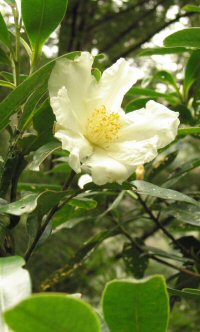 |
Polyspora axialis in Taiwan
By the time Peter and Du left I was under the impression that it could not get any better than this. Well it did. Sue arrived accompanied by Ben Kettle (from what was Rickard’s Hardy Ferns) again, despite the weather we came up trumps time and time again, you will not be disappointed in future years with these collections. Nor my following leg, which Sue unfortunately missed (running the mail order), was in Taiwan where I was joined by Dan Hinkley and Finlay Colley. Our hosts in the National Museum of Taiwan Natural Science, went way beyond their brief in helping us, which of course came to fruition in some wonderful collections.
The 2007 collecting trips were beyond all our expectations.
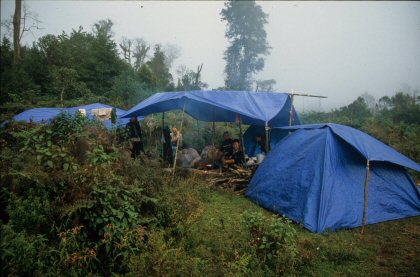 |
Camp at Y Ty
Peter Wharton joined me in the north of Vietnam, where I had been collecting with the aid of a motorbike. I had secured permits for collecting in a restricted area, where Peter would conduct a survey of this previously un-botanised area, while our Vietnamese host, Du was collecting specimen for his institute. The weather was dreadful, I wasn’t sure if I was going to end up with webbed feet or trenchfoot. Whatever, the collections kept on rolling in with new plants almost overwhelming us.
|  |
Polyspora axialis in Taiwan
By the time Peter and Du left I was under the impression that it could not get any better than this. Well it did. Sue arrived accompanied by Ben Kettle (from what was Rickard’s Hardy Ferns) again, despite the weather we came up trumps time and time again, you will not be disappointed in future years with these collections. Nor my following leg, which Sue unfortunately missed (running the mail order), was in Taiwan where I was joined by Dan Hinkley and Finlay Colley. Our hosts in the National Museum of Taiwan Natural Science, went way beyond their brief in helping us, which of course came to fruition in some wonderful collections.
Acquisition numbers for plants listed
| BSSS 001-300 |
Crûg expedition to Jordan 1991 |
| BSWJ 001-399 |
Bleddyn & Sue Wynn-Jones 1st expedition to Taiwan 1992 |
| BSWJ 501-1399 |
Bleddyn & Sue Wynn-Jones 1st expedition to Korea 1993 (accompanied by Dan Hinkley for part) |
| BSWJ 1400-2099 |
Bleddyn & Sue Wynn-Jones 2nd expedition to Taiwan 1993 |
| BSWJ 2100-2372 |
Bleddyn & Sue Wynn-Jones 1st expedition to West Bengal, N.India 1994 |
| BSWJ 2373-2799 |
Bleddyn & Sue Wynn-Jones 1st expedition to Sikkim 1994 |
| BSWJ 2800-2950 |
Bleddyn Wynn-Jones 1st expedition to Japan 1995 (with Dan Hinkley) |
| HWJCM 001-599 |
1st expedition to Eastern Nepal 1995 (Crûg-Heronswood joint expedition) |
| BSWJ 2951-2999 |
Bleddyn Wynn-Jones 1st expedition to Central Nepal 1995 |
| BSWJ 3000-3849 |
Bleddyn & Sue Wynn-Jones 3rd expedition to Taiwan 1996 |
| BSWJ 3850-4050 |
Bleddyn & Sue Wynn-Jones Philippines 1996
|
| BSWJ 4051-4099 |
Bleddyn & Sue Wynn-Jones Hong Kong 1996 |
| BSWJ 4100-4718a |
Bleddyn & Sue Wynn-Jones 2nd expedition to Korea 1997 (accompanied by Dan Hinkley et al) |
| BSWJ 4719-5149 |
Bleddyn & Sue Wynn-Jones 2nd expedition to Japan 1997 (accompanied by Dan Hinkley et al) |
| BSWJ 5150-5310 |
Bleddyn & Sue Wynn-Jones 1st expedition to Thailand 1997 |
| BSWJ 5311-5399 |
Bleddyn & Sue Wynn-Jones Japan (hort) 1998 |
| BSWJ 5400-6399 |
Bleddyn & Sue Wynn-Jones 3rd expedition to Southern Japan 1998 |
| BSWJ 6400-6699 |
Bleddyn & Sue Wynn-Jones 2nd expedition to Thailand 1998 |
| HWJ 500-799 |
1st expedition to North Vietnam 1999 (Crûg-Heronswood joint expedition) |
| BSWJ 6700-7149 |
Bleddyn & Sue Wynn-Jones 4th expedition to Taiwan 1999 (accompanied by Dan Hinkley for part) |
| BSWJ 7150-7299 |
Bleddyn Wynn-Jones 3rd expedition to Thailand 1999 |
| BSWJ 7300-7499 |
Bleddyn Wynn-Jones Japan (hort) 2000 (accompanied by Dan Hinkley) |
| BWJ 7500-8199 |
Bleddyn Wynn-Jones China 2000 (accompanied Dan Hinkley) |
| BSWJ 8200-8349 |
Bleddyn & Sue Wynn-Jones 2nd expedition to North Vietnam 2000 |
| BSWJ 8350-8399 |
Bleddyn & Sue Wynn-Jones expedition to Lao 2000 |
| BSWJ 8400-8859 |
Bleddyn & Sue Wynn-Jones 3rd expedition to Korea 2001 |
| BSWJ 8860-8979 |
Bleddyn & Sue Wynn-Jones 4th expedition to Japan 2001 |
| BSWJ 8980-9199 |
Bleddyn & Sue Wynn-Jones 1st expedition to Guatemala 2001 |
| HWJK 2001-2500 |
2nd expedition to Eastern Nepal 2002 (Crûg-Heronswood joint expedition) |
| GWJ 9200-9370 |
Sally Goddard, Bleddyn & Sue Wynn-Jones 2nd expedition to N.E. Sikkim 2002 |
| GWJ 9371-9459 |
Sally Goddard, Bleddyn & Sue Wynn-Jones 2nd expedition to West Bengal, N.India 2002 |
| GWJ 9460-9499 |
Sally Goddard, Bleddyn & Sue Wynn-Jones 1st expedition to Sri Lanka 2002 |
| BSWJ 9500-9549 |
Bleddyn & Sue Wynn-Jones South India 2002 |
| BSWJ 9550-9699 |
Bleddyn & Sue Wynn-Jones 1st expedition to Northwestern USA 2003 |
| HWJ 800-1099 |
3rd expedition to North Vietnam 2003 (Crûg-Heronswood joint expedition) |
| BSWJ 9700-9799 |
Bleddyn & Sue Wynn-Jones 3rd expedition to Vietnam (south) 2003 |
| RWJ 9800-10149 |
5th expedition to Taiwan 2003 (Crûg-Rickard’s Ferns joint expedition) |
| BSWJ 10150-10199 |
Bleddyn & Sue Wynn-Jones 2nd expedition to Sri Lanka 2003 |
| BSWJ 10200-10299 |
Bleddyn & Sue Wynn-Jones expedition to Mexico 2004 |
| BSWJ 10300-10449 |
Bleddyn & Sue Wynn-Jones 2nd expedition to Guatemala 2004 |
| BSWJ 10450-10549 |
Bleddyn & Sue Wynn-Jones expedition to Costa Rica 2004 |
| BSWJ 10550-10599 |
Bleddyn & Sue Wynn-Jones expedition to Panama 2004 |
| BSWJ 10600-10799 |
Bleddyn & Sue Wynn-Jones expedition to Colombia 2004
|
| BSWJ 10800-11249 |
Bleddyn & Sue Wynn-Jones 5th expedition to Japan 2005 |
| BSWJ 11250-11287 |
Bleddyn & Sue Wynn-Jones Indonesia 2005 |
| BSWJ 11288-11299a |
Bleddyn & Sue Wynn-Jones Malaysia 2005 |
| BSWJ 11300-11599 |
Bleddyn & Sue Wynn-Jones 6th expedition to Southern Japan 2006 |
| WWJ 11600-11682 |
Peter Wharton, Bleddyn Wynn-Jones 4th expedition to North Vietnam 2006 |
| BSWJ 11683-11849 |
Bleddyn & Sue Wynn-Jones 4th expedition to North Vietnam 2006 |
| WWJ 11850-12024 |
Peter Wharton, Bleddyn Wynn-Jones 5th expedition to North Vietnam 2007 |
| KWJ 12025-12349 |
Ben Kettle, B & S Wynn-Jones 5th expedition to North Vietnam 2007 (Crûg-World of Ferns joint expedition) |
| CWJ 12350-12499 |
Finlay Colley & Bleddyn Wynn-Jones expedition to Taiwan 2007 |
| BSWJ 12500-12524 |
Bleddyn & Sue Wynn-Jones 2nd expedition to Northwestern USA 2008 |
| BSWJ 12525-12549 |
Bleddyn & Sue Wynn-Jones expedition to The Azores 2008 & 2009 |
| BSWJ 12550-12799 |
Bleddyn & Sue Wynn-Jones 4th expedition to Korea 2010 |
| CWJ 12800-12899 |
Finlay Colley & Bleddyn Wynn-Jones expedition to Japan 2010 |
| BSWJ 12900-12969 |
Bleddyn & Sue Wynn-Jones North Carolina USA 2011 |
| FMWJ 13000-13499 |
Aaron Floden, Tom Mitchell & Bleddyn Wynn-Jones, Vietnam 2011 |
| BSWJ 12970-12999 |
Bleddyn & Sue Wynn-Jones Italy accessions 2012 |
| BSWJ 13500-13581 |
Bleddyn & Sue Wynn-Jones 4th expedition to Canada & northwestern USA 2013 |
| BSWJ 13582-13599 |
Bleddyn & Sue Wynn-Jones Spain accessions 2013 |
| BSWJ 13600-13627 |
Bleddyn & Sue Wynn-Jones France & Italy accessions 2013 |
| WJC 13650-13899 |
Bleddyn & Sue Wynn-Jones 3rd expedition to Sikkim; with Finlay Colley 2013 |
| BSWJ 13900-13999 |
Bleddyn & Sue Wynn-Jones 3rd expedition to West Bengal, N.India 2013 |
| BSWJ 14000-14019 |
Bleddyn & Sue Wynn-Jones Spain accessions 2014 |
| BSWJ 14020-14049 |
Bleddyn & Sue Wynn-Jones France & Italy accessions 2014 |
| BSWJ 14050-14199 |
Bleddyn & Sue Wynn-Jones 5th expedition to Canada & northwestern USA 2014 |
BSWJ 14200-
14449 | Bleddyn & Sue Wynn-Jones 2nd expedition to Colombia 2015 | | BSWJ 14450-14454 | Bleddyn & Sue Wynn-Jones 2nd expedition to Hong Kong 2015 | | NMWJ 14455-14599 | Taiwan National Museum of Natural Science, Bleddyn & Sue Wynn-Jones 7th expedition to Taiwan 2015 | | BSWJ 14600-14699 | Bleddyn & Sue Wynn-Jones 8th expedition to Japan 2015 | | BSWJ 14700-14999 | Bleddyn & Sue Wynn-Jones 3rd expedition to Colombia 2016 | | BSWJ 15000-15039 | Bleddyn & Sue Wynn-Jones France, Sicily & Italy accessions 2016 | | BSWJ 15040-15068 | Bleddyn Wynn-Jones Morocco accessions 2016 | | BSWJ 15069-15099 | Bleddyn & Sue Wynn-Jones Spain accessions 2016 | | BSWJ 15100-15149 | Bleddyn & Sue Wynn-Jones Madeira accessions 2017 | | BWJ 15150-15229 | Bleddyn Wynn-Jones 7th expedition to Vietnam 2017 | | BSWJ 15230-15299 | Bleddyn & Sue Wynn-Jones expedition to Italy and Slovenia 2017 | | BSWJ 15300-15369 | Bleddyn & Sue Wynn-Jones Turkey accessions 2017 | | BSWJ 15370-15421 | Bleddyn & Sue Wynn-Jones Georgia expedition with Batumi BG 2017 | | BSWJ 15422-15499 | Bleddyn & Sue Wynn-Jones USA North Carolina accessions 2017 | | BWJ 15500-15699 | Bleddyn Wynn-Jones Vietnam northern December 2017 | | BWJ 15700-15899 | Bleddyn Wynn-Jones Vietnam central & southern January 2018 | | BWSJ 15900-15923 | Bleddyn & Sue Wynn-Jones Croatia accessions June 2018 | | BWSJ 15924/30-15967 | Bleddyn & Sue Wynn-Jones France & Italy February & June 2018 | | BWSJ 15931-15976 | Bleddyn & Sue Wynn-Jones USA WA July 2018 | | BWSJ 15977-15999 | Bleddyn & Sue Wynn-Jones Domestic Cambridge BG etc 2018 | | BWSJ 16000-16099 | Bleddyn & Sue Wynn-Jones Russia September accessions 2018 | | BWJ 16100-16329 | Bleddyn Wynn-Jones Vietnam northern December accessions 2018 | | BWSJ 16351-16376 | Bleddyn & Sue Wynn-Jones Abkhazia September accessions 2019 | | BWSJ 16330-350-16377-399 | Bleddyn & Sue Wynn-Jones Russia September accessions 2019 | | BSWJ 16400-16499 | Bleddyn & Sue Wynn-Jones 4th expedition to Colombia 2024 | | HWJ 24001-24110 | Dan Hinkley, Bleddyn & Sue Wynn-Jones expedition to Taiwan 2024 |
The Himalayas 2013
It had been eleven years since we had last visited The Himalayas, how things have changed in that relatively short time. Times have changed no doubt, along with costs which no longer appear to be third world. Looking back at our last collections (before booking) from there in 2002, accompanied with our friend Sally Goddard, our interests were certainly less woody. So it left us with plenty of scope to extend our range with new collections.
This time we invited Finlay Colley from Ireland, who has accompanied me on a couple of previous expeditions, as well as Koen Van de Pock from Belgium. I had previously run into Koen in Vietnam, when he was accompanied by his wife Ann. They had been such good companions that we did not hesitate in inviting them to share the travelling, after all they had been great at seed cleaning (more of that later). All was arranged for an earlier time of the season than previously, mid September, which unfortunately meant that Ann could not come along, as their flower shop was still busy at that time. We had not managed to get to Sikkim before mid November on our two previous expeditions, which meant that our choice of collections would be greatly extended this time.
Hence on the 17th we all met up in Schipol Airport, in time for lunch, before our flight to Delhi, which arrived at the delectable time of 2 a.m.. Been aware of the hassles we had pre-booked somewhere to lay our heads down before our continuing journey to Bagdogra, where we had arranged to be picked up and driven to the balmy climate of Kalingpong. One of the biggest hassles of these types of trips is all the equipment that has to be taken along, luckily for us KLM had an offer of a cheap rate for an additional bag, which we grabbed, as we would be even more heavily burdened on our return journey. Unfortunately there was no offer on additional baggage on our connecting flight to Bagdogra, which translated into three times the cost of flying a bag half way around the world and back.
 Crawfurdia speciosa
Back to the job in hand, the first hurdle was getting permits, which was duly seen to while we enjoyed a pleasant lunch, thanks to Sailesh, who had organized everything. In fact this character was busying himself finding out our every desires, what type of food or drink we liked what we would like to see etc. etc.. As soon as he realized that we all appreciated tasting new foods, he was off on a quest, we had hit a nerve, that and the demon drink were his pet loves. We were destined to try everything. We were soon installed in a suitably quiet hotel, while the permits to visit the north were organized. Allowing us to head strait out the following morning on the long journey. As mentioned we had been along this road twice before, but we were still not prepared for the severe deterioration in the road. Apparently there is a major hydro-electric construction being undertaken in numerous sites up and down all of these deep valleys. This compounded by two consecutive years of major earthquakes had torn the area to bits. At least we were able to stop on route and collect seed of one of our primary target plants, namely Daphniphyllum chartaceum, which we found with plenty of fruit on a couple of trees close to the road. This was important as we not only required seed, but pressed specimens to prove that this species is quite different to D. himalayense, which it had been reduced to a synonym of. This task duly tucked under our belts was truly a great start to our trip, even if it was all that we had been able to collect on our first day in the field.
It was well dark by the time we reached our destination, but the welcome was warm as ever and we were soon installed in our temporary lodgings. Another early start was arranged for the following day, we were biting at the bit. No less so by the morning which had us piled into out vehicle and on our way north up the valley. Not that we got very far, we were stopped in our tracks by a stand of Actaea frigida, not far from the village, soon to be repeated by the sight of Angelica cyclocarpa, which must rate as one of the most spectacular species going with an inflorescence a meter across on tall chunky stems. That is one to look forward to seeing in full flow.
The next one to hit us was the sheer quantity of Schisandra fruit that seemed to be hanging from virtually everywhere. The advantage of coming early was becoming apparent. It did not take long for another wave of fruit to crash over us, this time in the form of Magnolia globosa. Now I had been led to believe that this species needed careful siting in a garden to help protect it from cold, yet here it was at an altitude approaching 3,000m (as well as well above). It grieved us to leave so much behind, but you can’t eat it, whereas the birds can. Talking of which, the bird population was abundant and not shy either, reflecting the Buddhist philosophy, who do not hunt anything that moves to extinction, as we have born witness to in far too many other countries.
Decaisnea insignis
There were plenty of other lesser collections being found, inevitably at quite some pace on our first day, but some have to be mentioned. Aconitum bulbiliferum is no doubt a star if you can provide it with a cool enough position, we had collected on both previous expeditions in this valley, but this was deep purple in flower. Superb. So was the heavy crop of seed on Acer sikkimense, a species which had previously eluded us, possibly due to our late arrival. It will be interesting to compare it with our collections from northern Vietnam. Then last to be mentioned was Daphniphyllum himalayense, abundant at 3,000m, where it was forming colonies not quite on the scale of all the rhododendrons we were seeing, but never the less a prominent evergreen conspicuous because of its dark green glossy leaves, appearing to be one of the afore mentioned rhododendrons to the casual observer. As suspected the fruit on all of this species was still embryonic, a phenomena that as far as I know is a unique feature to this species, yet I have never seen a reference to it. Is Daphniphyllum such a botanically/taxonomically neglected genus that nobody can be bothered to record such facts, hence the ludicrous situation with D. chartaceum mentioned above? Or the fact that it is a perfectly hardy species, possibly the most hardy, yet all references in horticulture state it to be tender, probably like the rest of the plants we find at 3,200m in this part of the Himalayas?
After a long evening recording the day’s accessions, I felt more than a little apprehensive, as we would not be able to cope with processing the quantity at this level, but it was after all still the first day. Next morning we were there again biting at the bit, but for our second morning I had earmarked a small side-valley, before we commenced further up the Valley. Reason being that we were after fruit of Merrilopanax alpina, having only been successful in raising a handful of plants from our previous visit and seen the public reaction to it on our Chelsea Flower Show stand. I had recorded it as being abundant in this one valley, I was proved correct. Not long after entering the valley it was apparent on the vertical sides, it did not take long to work our way up the side of the valley to a position where we could overload on its ripe fruit. If the plants we saw there are anything to go by we will not disappoint those forming an orderly que. We also took advantage of the large specimen of Rhododendron falconeri there with exceptionally large foliage well embellished with a gingery indumentum. Has to be in everyone’s top ten plants. Before moving on we were looking for a superb form of Sorbus hedlundii, which we had collected previously, the disappointment of fining it without fruit was soon forgotten, when I spotted some gorgeous foliage on a small tree. It was five-foliate, like a deciduous Schefflera ……….. with fruit in terminal panicles, we had to have it. We did! Gamblea ciliata will soon be topping many a shopping list, its going to be the next cool plant. Cool as it’s a good hardy species, fingers crossed it germinates.
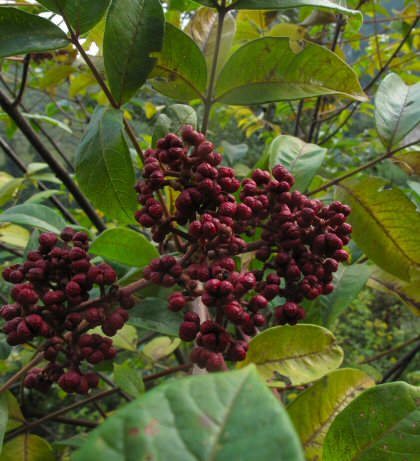
Tetradium fraxinifolium WJC13750
Feeling pleased with our morning’s work we made our way back up the valley, dipping into the sea of rhododendrons periodically. How do you select from one of the best populations in the world, not just diversity, but the quality of the species was outstanding. Herbaceous plants were also cropping up in some interesting guises Paris, Panax, Cremanthodium and Aconitum were all interesting, but it was one of the Rhodiola that impressed us the most. We found R. chrysanthemifolia growing on mossy tree trunks as well as vertical stone faces displaying their bright pink flowers against a tight ruff of deeply lobed fleshy leaves. Another plant that is destined to be popular. Curious as we had encountered this plant in the past, but never in this form nor at this stage with impressive autumnal hues. We had collected the white fruit of Sorbus microphylla in this area, but S. rufopilosa was new certainly to me, with longer more leafleted foliage and pink fruit. We had also come across Viburnum nervosum, but I could not remember finding it on this scale before, curiously or inexplicably absent from cultivation, it was difficult to believe that such a stunning and distinct in foliage species has not been introduced into general cultivation before. The valley was awash with its large curiously glossy distinctly veined foliage with plenty of its showy red turning to black fruit present to tempt all the bird life to distribute its seed.
The following day started well with the discovery of a wonderful crop of Decaisnea insignia in a Monastery, which they were more than happy to part with, all be it a little bemused. It took a second take to recognise the curious yellow fruit accompanying the more familiar large pinnate foliage. This is also where we found the first of many ornamentally viable species of Impatiens, which will have to wait in line for their identity. If they all germinate we are in for a colourful display. This was also the day that we were to move west to another Valley where we encountered I. falcifer for the first of many sightings, a curiously shaped bright yellow species with red spotting in zonal patches. It was at the lower end of the valley that we also came across two magnificent Araliaceae, Brassaiopsis mitis and Trevesia palmata. Very much of the same vein as Tetrapanax, but taller, very imposing, and unfortunately without seed, but certainly on the list for the future. Here we also found our first selection of Hydrangea aspera subsp. robusta, one of if not the most impressive species in the aspera group. Curiously common for most of the length of this valley was Tetradium fraxinifolia forming small pleasantly umbrella-shaped trees with chunky pinnate foliage and large clusters of reddish fruit, which would later split to reveal the black glossy seed held within. Closely related to the increasingly popular Sichuan Pepper, we were not surprised to find it offered for sale in the local vegetable markets, as an alternative (or even better than) its Chinese relative. Again it is far too lengthy an exercise to list everything that we collected or saw that day, but the sighting of a small group of Shappy, a type of rare deer that were very rarely spotted was certainly a highlight. As indeed was finding Lindera heterophylla, just before we ran out of light that day. Shame we were too late for its black fruit, curious that it has been lumped with L. obtusilobum by some as its foliage is substantially different.
Our final day in the western Valley was, well a disappointment. Too much ground to cover left us too little time to investigate any areas well. Even when we gained some substantial altitude to well over 4,000m there was very little diversity left, what little seed there was had gone. We were mystified as previously the higher areas were good, but the military was crawling all over the place, not sure if they could be blamed, but only a single Meconopsis plant was spotted where as in 2002 we were able to collect three species alongside the road, with my noted recording that they were common here. We did find another species of Angelica though, although some authorities question there being two species in this area, it was equally as chunky as A. cyclocarpa, but only a meter tall, time will tell (germination willing).
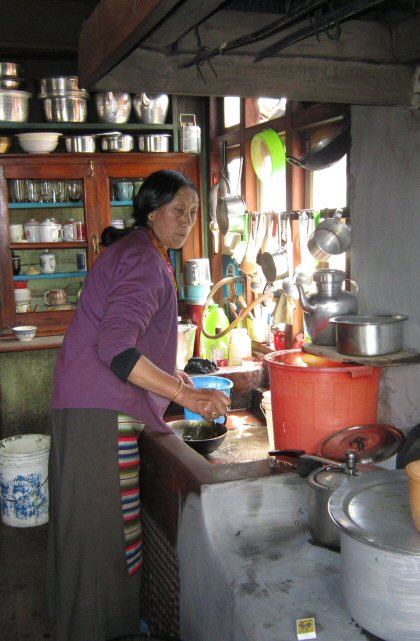
It was late by the time we had renegotiated the roads out of northern section, as our permits were expiring that day, we had to make our way to south. This left us with the prospect of a low elevation run back the following day, which we made the best of gathering more of the Hydrangea as well as several collections of Codonopsis. While entering the capital via some interesting experimental forestry areas, where we first encountered Exbucklandia populnea as well as Daphniphyllum chartaceum being grown for timber. Interesting.
Back in the city was not to be a rest period, we had a mountain of seed to clean, which is exactly what we buckled down to do. All too soon we were on our way further west, which was yet another long drive, through some very pleasant countryside though. Unfortunately most of this was far too low an altitude for us to take advantage of, although we did manage to grab some Dobinea seed, just in case there was not any left on our trek.
.

We are often asked which countries we have collected in. We have listed below the trips we have made over the years along with the acquisition numbers on the left. Every collection is carefully documented with all the relevant information needed. Site, altitude etc
1991
Jordan
1992
Taiwan
1993
Korea & Taiwan
1994
West Bengal, N.India & Sikkim
1995
Japan, E.Nepal & C.Nepal
1996
Taiwan, Philippines & Hong Kong
1997
Korea, Japan & Thailand
1998
Japan (hort), S. Japan & Thailand
1999
N.Vietnam, Taiwan & Thailand
2000
Japan (hort), China, N.Vietnam & Lao
2001
Korea, Japan & Guatemala
2002
E.Nepal, N.E. Sikkim, West Bengal, N.India, Sri Lanka & S. India
2003
Northwestern USA, N.Vietnam, S.Vietnam, Taiwan & Sri Lanka
2004
Mexico, Guatemala, Costa Rica, Panama & Colombia
2005
Japan, Indonesia & Malaysia
2006
S.Japan & N.Vietnam
2007
N.Vietnam & Taiwan
2008
Northwestern USA & The Azores
2009
The Azores
2010
Korea, Japan
2011
northern Vietnam
2012
South France & Italy
2013
Spain North America Sikkim & north India
2014
Spain France & Italy North America
2015
Colombia, Hong Kong, Taiwan & Japan
2016
Colombia, France, Sicily, Italy, Morocco & Spain
2017
Madeira, Vietnam northern, Italy, Slovenia, Turkey, Georgia, USA NC, Vietnam northern
2018
Vietnam central & southern, France &Italy, Croatia, USA WA, Russia, Vietnam northern
2019
Italy & France, Abkhazia, Russia
2024
Colombia, Taiwan
| |